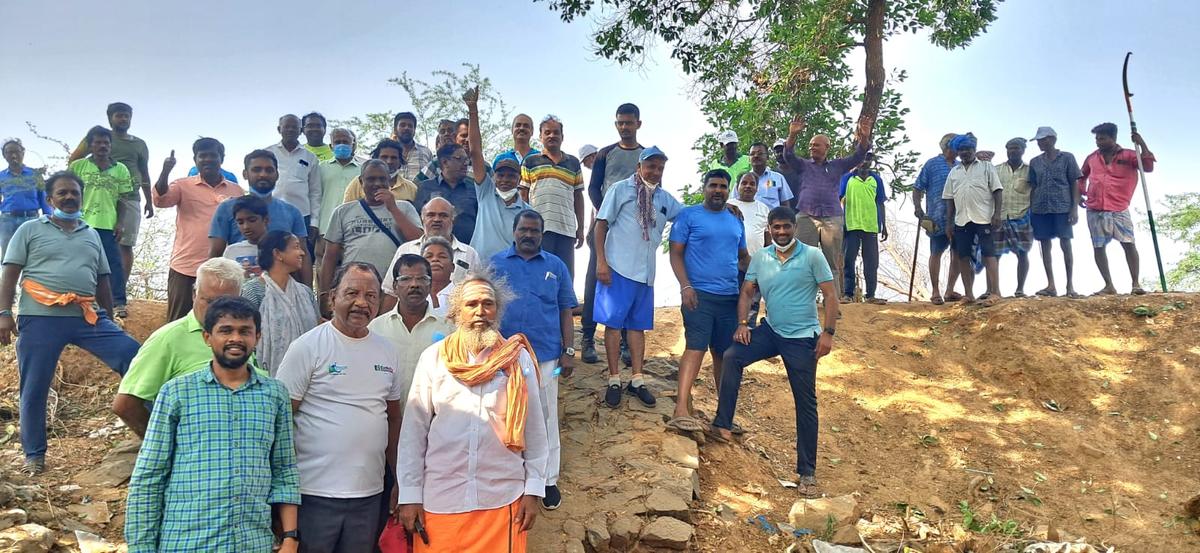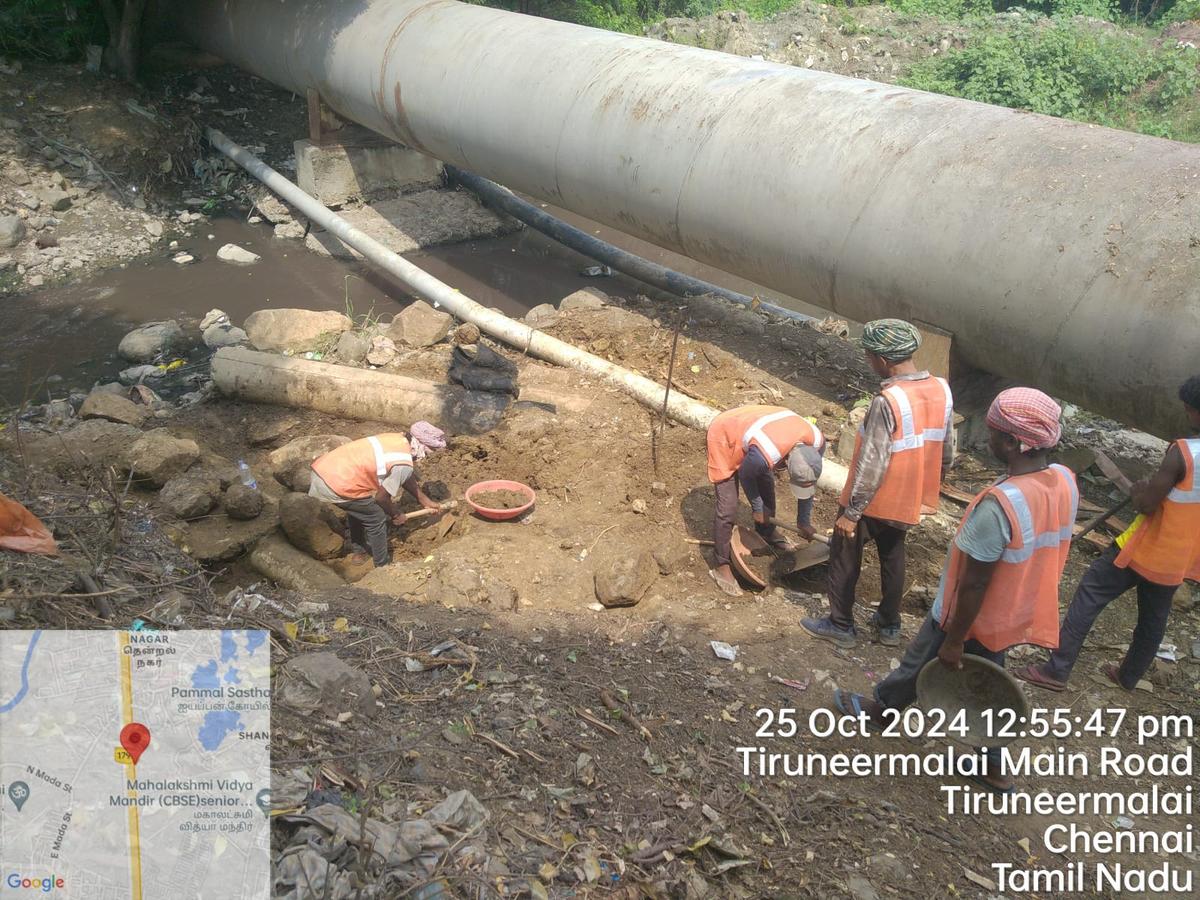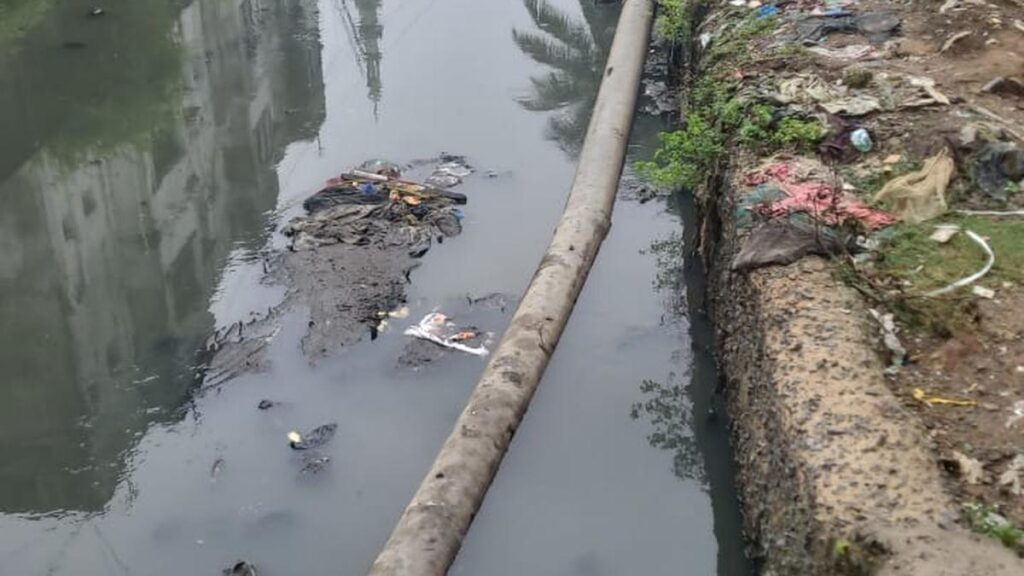Thiruneermalai Periya Eri is a supersized waterbody lying spread-eagle and claiming pieces of three wards (29, 30 and 31) within Tambaram Municipal Corporation limits. This waterbody has a neighbour, only a few addresses removed, named Veeraraghavan Eri.
During NE monsoon, the connectedness between these lakes stands out in bold relief.
Pachai Malai, a dwarfish hill in Tambaram Sanatorium, “supplies” rainwater to Chitlapakkam Lake on its east and Veeraraghavan Eri on its west. Filled-up, Veeraraghavan Eri disgorges rainwater, which gushes into Tiruneermalai Periya Eri. Thiruneermalai Periya Eri spits out the excess water into a rainwater-carrying channel called Nattu Kalavi, which courses through residential areas, slithers under the Maduravoyal-Irumbuliyur Bypass Road and meets Adyar river. The course of Nattu Kalvai being beset with challenges, neighbourhoods on both sides of it face flooding during NE monsoon, says B. Saravanan, a resident of Thiruneermalai and a member of Thiruneermalai Periya Eri Paathukappu Kuzhu and a social activist, while presenting this graphic picture to nail the rainwater-flow dynamics of the region.

An awareness rally at Thiruneermalai Periya Eri

“It is the Thiruneermalai Periya Eri Paathukappu Kuzhu’s plea that the Chief Minister prioritise this project and sanction it so that work could be executed during summer and residents are spared flooding during NE monsoon”
Prominent members of Thiruneermalai Periya Eri Paathukappu Kuzhu, including Perumal, Arulmozhi, Kumaran and Saravanan are in the forefront of a drive to have residents’ concerns about flooding in these parts heard by officials in government line agencies that can reverse this situation. On May 4 and July 28, both in year 2024, the group organised a clean-up drive at Thiruneermalai Periya Eri and an awareness rally around the issue respectively.
Saravanan continues: “If you imagined a funnel, you would gain a mental picture of Nattu Kalvai. Where the Nattu Kalvai nuzzles close to Thiruneermalai Periya Eri, it is 60 feet wide, serving as a Kalangal, a catchment area for water overflowing from the lake.”
And a 50-metre amble later, when it crosses over to the other side of Thiruneermalai Main Road, it appears emaciated, reduced by half (just 30 feet wide now), as if it had been through an ill-advised diet plan.

A temporary measure being undertaken on
Nattu Kalvai
“When it crosses Saraswathipuram First Street, it would be 20 feet wide, and while running parallel to Saraswathipuram Fourth Street Extension, it gets narrower still, slimming down to 15 feet. It heads to Ranga Nagar Third Street, followed by an area called Temple Town; after which it would run near the entrance of a massive gated community, Jain Alpine Meadows, and 300 metres further, it touches the Maduravoyal-Irumbuliyur Bypass Road, which comes under NHAI. Before it reaches the bypass road, it gets slightly wider, and its movement towards Adyar river on the other side is enabled by a box culvert under the bypass road. The flow of rainwater through Nattu Kalvai in this part is hampered by the presence of a pipeline of four-feet diameter pertaining to the Veeranam water supply scheme, which comes under the State government. The pipeline crosses Nattu Kalvai, slowing down the rainwater flow in the latter,” says Saravanan.
“Ten feet away from the Veeranam pipeline, rainwater has to flow through a 3X3 box culvert (ten feet high) under the bypass road, and due to the dimensions of this culvert, the flow slows down further. As a compounded effect of all the impediments during its course, Nattu Kalvai spews out rainwater into various residential settlements — Alpine Meadows, Saraswathipuram Fourth Street Extension, Ranga Nagar Third Street, Subbarayan Nagar, MSK Street, Kaasi Garden and Temple Town.”
Saravanan sent a petition to National Highways Authority of India (NHAI) through Centralised Public Grievance Redress and Monitoring System (CPGRAMS) seeking their help, and an NHAI reply stated that the regional officer and project director would study the issue, making an inspection and also meeting with residents.
“They made good their promise, arriving for an inspection by the end of October in 2024. We were present during the inspection and raised our concerns. They heard us out and promised to carry our a temporary measure ahead of the NE Monsoon. They pointed out that they would need to have three more box culverts, each ten feet high to increase the width, thereby facilitating easy flow of rainwater past the bypass road. They said this has to be communicated to the regional office with a clearly drawn estimate to find out if it could be cleared with permission from the regional office or from the head office in Delhi. Meanwhile, as a temporary measure, workers were employed to clear the sediment formed under the Veeranam pipeline to ensure smoother flow of rainwater. The help from this measure was negligible.”
Saravanan notes that an RTI petition he had sent to the state government had elicited a reply on October 10, 2024, stating that a project plan for a Water Resources Department-led restoration of Thiruneermalai Periya Eri and Nattu Kalvai at a cost of ₹53.3 crores had been drawn up. It was awaiting sanction, having been placed on a priority list.
Saravanan observes: “It is the Thiruneermalai Periya Eri Paathukappu Kuzhu’s plea that the Chief Minister prioritise this project and sanction it so that work could be executed during summer and residents are spared flooding during NE monsoon,” says Saravanan. “What is required to prevent flooding in these parts is deepening and desilting of Thiruneermalai Periya Eri, creation of walkways on the bunds, which would ensure protection of the lake and also ensure the bunds would not be broken during heavy rains. Nattu Kalvai is shallow just two to 2.5 feet deep; it has to be deepened, and the side wall raised higher so that water does not overflow. Besides, Nattu Kalvai should be made a closed channel. In addition to this measure by WRD, provision of additional box culverts at the bypass road by NHAI will ensure flooding-free residential areas in these parts during NE Monsoon.”
Published – February 08, 2025 05:56 pm IST
Source:https://www.thehindu.com/news/cities/chennai/take-up-work-on-thiruneermalai-periya-eri-nattu-kalvai-on-a-war-footing/article69196054.ece

